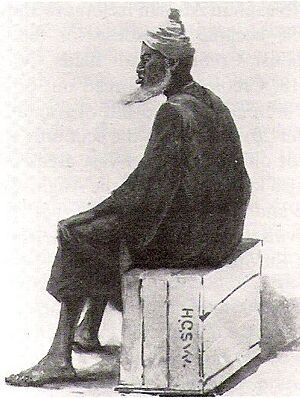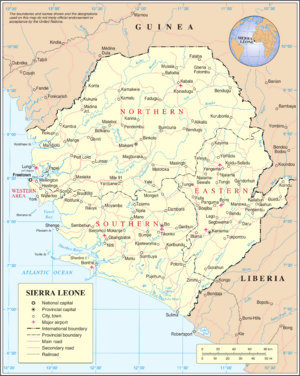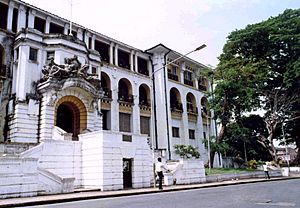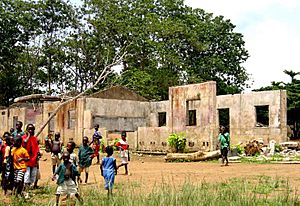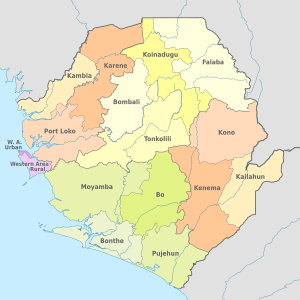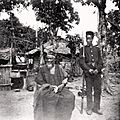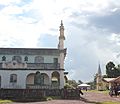Sierra Leone facts for kids
Quick facts for kids
Republic of Sierra Leone
Ripɔblik fɔ Siera Liɔn (Krio)
|
|
|---|---|
|
|
|
|
Motto: "Unity, Freedom, Justice"
|
|
|
Anthem: "High We Exalt Thee, Realm of the Free"
|
|

Location of Sierra Leone (dark green)
|
|
| Capital and largest city
|
Freetown 08°30′00″N 12°06′00″W / 8.50000°N 12.10000°W |
| Official languages | English |
| Recognised national languages | Krio |
| Ethnic groups
(2015)
|
|
| Religion
(2020)
|
|
| Demonym(s) | Sierra Leonean |
| Government | Unitary presidential republic |
| Julius Maada Bio | |
| Mohamed Juldeh Jalloh | |
|
• Chief Minister
|
David Sengeh |
| Legislature | Parliament |
| Independence
from the United Kingdom
|
|
|
• Dominion
|
27 April 1961 |
|
• Republic
|
19 April 1971 |
| Area | |
|
• Total
|
71,740 km2 (27,700 sq mi) (117th) |
|
• Water (%)
|
1.1 |
| Population | |
|
• 2023 estimate
|
8,908,040 (100th) |
|
• Density
|
124/km2 (321.2/sq mi) (114tha) |
| GDP (PPP) | 2024 estimate |
|
• Total
|
|
|
• Per capita
|
|
| GDP (nominal) | 2024 estimate |
|
• Total
|
|
|
• Per capita
|
|
| Gini (2024) | 33.7 medium |
| HDI (2024) | low · 184th |
| Currency | Leone (SLE) |
| Time zone | UTC (GMT) |
| Date format | dd/mm/yyyy |
| Driving side | right |
| Calling code | +232 |
| ISO 3166 code | SL |
| Internet TLD | .sl |
|
|
Sierra Leone is a country in West Africa. Its capital city is Freetown. The official language spoken there is English.
This country was first created as a home for freed slaves. From 1991 to 2000, Sierra Leone had a civil war between rebels and the government. The war is now over. Sierra Leone is known for its blood diamonds. These diamonds were mined and sold to buy weapons during the civil war.
Sierra Leone covers 71,740 square kilometers of land. This makes it similar in size to Ireland.
The country's economy relies heavily on mining, especially diamonds. Sierra Leone is a big producer of titanium and bauxite. It also produces a lot of gold. The country has one of the world's largest deposits of rutile. Sierra Leone also has the third largest natural harbor in the world. Ships from all over the globe visit Freetown's famous Queen Elizabeth II Quay. Even with all this natural wealth, 70% of its people live in poverty.
Sierra Leone is mostly a Muslim country.
The country has many different kinds of plants and animals. There are 2,090 known species of higher plants. It is home to 147 types of mammals, 626 birds, 67 reptiles, 35 amphibians, and 99 fish species.
Contents
About Sierra Leone's Name
Sierra Leone gets its name from the Lion Mountains near its capital, Freetown. A Portuguese explorer named Pedro de Sintra called it Serra Leoa in 1462. This means 'lioness mountains' in Portuguese. The name we use today comes from a different spelling. This spelling was brought by a Venetian explorer named Alvise Cadamosto. Other European mapmakers then started using it.
Sierra Leone's Past
Early Times
Sierra Leone has been home to people for at least 2,500 years. People moved here from different parts of Africa. By the 9th century, they started using iron tools. By 1000 AD, farming began along the coast. Changes in climate over time affected how people moved and lived.
The thick tropical rainforests and swamps, along with the tsetse fly, protected the region. The tsetse fly carried a disease that was deadly to horses and cattle. This kept large empires like the Mali Empire from easily invading. So, the local cultures stayed strong. Islam arrived in the 18th century with Susu traders. It became very important in the north.
European Traders Arrive
In the 15th century, Europeans started coming to Sierra Leone. The Portuguese explorer Pedro de Sintra mapped the area in 1462. He named it after the lioness mountains. After Sintra, European traders set up posts. They mainly traded in slaves. Local African traders brought slaves from inland areas to the coast. Europeans paid a fee called Cole to local kings for trading rights. Local merchants often helped as middlemen.
Portuguese traders were very interested in local ivory carvings. These included horns, saltcellars, and spoons. The Sapi people lived in the area of modern-day Sierra Leone. They were already skilled carvers before the Portuguese arrived. Many travelers took carved ivory horns back to Europe. One writer in the 16th century noted how beautifully carved the ivory necklaces were.
Freed Slaves from London
In the late 1700s, many African Americans who fought for the British during the American Revolutionary War were freed. They were called Black Loyalists. Thousands of these people were moved to Sierra Leone. This was partly to help with social issues in London. The plan was to give the Black Poor a new start. However, it was a very difficult journey.
About 400 Black and 60 White settlers arrived in Sierra Leone in May 1787. They started a settlement called Granville Town. But many died from disease and fighting with the local Temne people. The Temne did not want them taking their land. Only 64 settlers remained. They started a second Granville Town. Some Black settlers were even captured and sold back into slavery.
Settlers from Nova Scotia
After the American Revolution, over 3,000 Black Loyalists also settled in Nova Scotia, Canada. They started Birchtown. But they faced harsh winters and unfair treatment. A leader named Thomas Peters asked British officials for help. The Sierra Leone Company was formed to move these Black Loyalists to West Africa.
In 1792, nearly 1,200 people from Nova Scotia sailed to Sierra Leone. They built the settlement of Freetown on March 11, 1792. These settlers were called the Nova Scotian Settlers. They built Freetown like the towns they knew in America. Many also continued to practice Methodism.
In the 1790s, the settlers, including women, voted in elections. In 1792, all heads of households could vote. About a third of these were women. This was very early for women's voting rights. Black settlers had more say in their government than white people in Europe. They elected leaders called 'tithingmen' and 'hundreders'. But life in Freetown was hard. The British did not send enough supplies. There was also a constant threat of illegal slave trading.
Jamaican Maroons and Liberated Africans
The Sierra Leone Company, run by investors in London, did not let the settlers own their land freely. In 1799, some settlers rebelled. The British brought in over 500 Jamaican Maroons to stop the revolt. These Maroons were transported from Cudjoe's Town (Trelawny Town) in Jamaica, through Nova Scotia, in 1800. The Maroons helped the British put down the revolt. They then got the best houses and farms.
On January 1, 1808, the Sierra Leone Company stopped running the Colony. The British Crown took over. The company was reorganized to help improve the local economy. Around the same time, the slave trade was abolished in 1807. British Navy ships brought thousands of formerly enslaved Africans to Freetown. These people were called Liberated Africans. They had been freed from illegal slave ships.
Many Liberated Africans were treated unfairly. Some original settlers saw them as property. They were forced to adopt Western ways. For example, some had to change their names to sound more Western. While some accepted these changes, others were unhappy. They even risked being sold back into slavery to return to their homes. Over time, the Liberated Africans blended their customs with those of the Nova Scotians and Maroons. They became successful traders and spread Christianity. They married each other, forming a new group called the Creole/Krio people. They also developed an English-based creole language called Krio. Krio is now the main language used among many groups in the country.
British Colonial Rule (1800–1961)
During British rule, Sierra Leone became a unique place. It was settled by Africans who had been displaced after the slave trade was abolished. When freed Africans arrived, they were given a registration number. Information about them was put into a register. Many changed their names to English versions, which made them hard to track.
In the early 1800s, Freetown was where the British colonial governor lived. This governor also managed other British colonies in West Africa. Sierra Leone became a center for education in British West Africa. The British started Fourah Bay College in 1827. It was the only European-style university in West Sub-Saharan Africa for over a century. Students from all over West Africa came to study there. Freetown became known as the "Athens of Africa" because of its many excellent schools.
The British mostly worked with the Krio people in Freetown. Krio people did most of the trading with people in the interior. Educated Krio people held many jobs in the colonial government. After the Berlin Conference in 1884–85, the British wanted more control over inland areas. They took over these areas in 1896, calling them the Sierra Leone Protectorate. The British then started giving more government jobs to British citizens. Krio people lost some of their positions and even desirable places to live in Freetown.
During British rule, chiefs in the north and south resisted a "hut tax." This was a tax on their homes. In the north, a Limba chief named Almamy Suluku used diplomacy and sent fighters to help Bai Bureh. Bai Bureh was a famous Temne chief fighting the "hut tax." This conflict became known as the Hut Tax War of 1898.
Madam Yoko (around 1849–1906) was a powerful woman. She used her skills to convince the British to give her control of the Kpaa Mende chiefdom. She also talked to local chiefs who did not trust her friendship with the British. Because Madam Yoko supported the British, some sub-chiefs rebelled. Madam Yoko had to hide in police barracks. For her loyalty, Queen Victoria gave her a silver medal. Madam Yoko ruled as a paramount chief until 1906.
The British taking over the Protectorate affected the power of local chiefs. They treated chiefs as local government units, not as individual allies. Even long-time allies like Bai Bureh were treated unfairly. Colonel Frederic Cardew, the military governor, set a new tax on homes in 1898. He also demanded that chiefs make their people maintain roads. The taxes were often too high. Chiefs said their people could not afford to stop farming to pay taxes. They resisted paying. This led to the Hut Tax War.
Bai Bureh's fighters fought well against the British for several months. Both sides lost many lives. Bai Bureh surrendered on November 11, 1898. He did this to stop the destruction of his people's land. The British government wanted to be lenient. But Cardew sent Bai Bureh and two allies away to the Gold Coast. His government executed 96 of the chief's warriors. Bai Bureh was allowed to return in 1905. He continued to be chief of Kasseh. The defeat in the Hut Tax War ended large-scale resistance to British rule. However, smaller riots and labor problems continued.
Domestic slavery, which was still practiced by some local African leaders, was ended in 1928. In 1935, a company called the Sierra Leone Selection Trust got a special right to mine all minerals. This right was to last for 98 years. Diamond mining in the east grew. This drew workers from other parts of the country.
In 1924, the UK government divided Sierra Leone into two parts: the Colony and the Protectorate. Each had different political systems. The Colony was Freetown and its coast. The Protectorate was the inland areas ruled by local chiefs. There was tension between these two parts. In 1947, there were ideas to create one political system for both. Most ideas came from Protectorate leaders, who had more people. The Krios, led by Isaac Wallace-Johnson, did not like these ideas. They feared losing their political power.
In 1951, Lamina Sankoh worked with educated leaders from the Protectorate. They formed the Sierra Leone People's Party (SLPP). This party became very popular. The SLPP leaders, led by Sir Milton Margai, talked with the British. They also talked with the Krio leaders in Freetown to gain independence. Margai was skilled at bringing different groups together. He helped the educated Protectorate leaders and powerful chiefs work with Krio leaders. This helped Sierra Leone gain independence from the UK.
In November 1951, Margai helped create a new constitution. This constitution brought together the Colony and Protectorate legislatures. It also set up a plan for decolonization. In 1953, Sierra Leone got local ministerial powers. Margai was elected Chief Minister of Sierra Leone. The new constitution made Sierra Leone a parliamentary system within the Commonwealth of Nations. In May 1957, Sierra Leone held its first parliamentary election. The SLPP won most seats, and Margai was re-elected Chief Minister.
Independence and Beyond
Sierra Leone became independent from the United Kingdom on April 27, 1961. It became its own country with its own government.
Becoming an Independent Nation
On April 20, 1960, Milton Margai led a group of 24 Sierra Leonean leaders. They met with the British government in London to discuss independence. They talked with Queen Elizabeth II's government and the British Colonial Secretary.
After these talks, the United Kingdom agreed to give Sierra Leone independence on April 27, 1961.
From 1961 to Today
On April 27, 1961, Sir Milton Margai led Sierra Leone to independence from Great Britain. He became the country's first prime minister. Sierra Leone now had its own parliament and prime minister. It could make all its own laws. Like Canada and Australia, Sierra Leone remained a "Dominion." This meant Queen Elizabeth was still Queen of the independent Dominion of Sierra Leone. Thousands of Sierra Leoneans celebrated in the streets. The Dominion of Sierra Leone kept a parliamentary government and was part of the Commonwealth of Nations.
In May 1962, Sierra Leone held its first general election as an independent country.
In 1971, under Prime Minister Siaka Stevens, the country changed its constitution. Sierra Leone became a presidential republic. Stevens became the first president. In 1978, Stevens declared his party, the All People's Congress (APC), the only legal party. In 1985, Joseph Saidu Momoh took over as president. Momoh brought back a multi-party system with a new constitution in 1991. That same year, a long civil war started. It was between the government and a rebel group called the Revolutionary United Front (RUF). The war lasted for 11 years and included many coups. Forces from ECOMOG and later the United Kingdom helped defeat the RUF in 2002. This brought a time of peace and stability.
Sierra Leone's Land and Climate
Sierra Leone is on the southwest coast of West Africa. It is mostly between 7° and 10° North latitude and 10° and 14° West longitude. The country shares borders with Guinea to the north and east. Liberia is to the southeast. The Atlantic Ocean is to the west and southwest.
Sierra Leone has a total area of 71,740 square kilometers. About 71,620 square kilometers are land, and 120 square kilometers are water. The country has four main geographical areas. In eastern Sierra Leone, there are high mountains and a plateau. Mount Bintumani is the highest point, at 1,948 meters.
The center of the country has lowland plains. These areas have forests, bush, and farmland. This covers about 43% of Sierra Leone's land. The northern part of this area is a mix of forest and savanna. The southern part has rainforests and farmland.
In the west, Sierra Leone has about 400 kilometers of Atlantic coastline. This means it has rich ocean resources and beautiful places for tourists. The coast has low-lying Guinean mangroves swamps. The capital city, Freetown, is on a peninsula next to the Sierra Leone Harbour.
The climate is tropical. There are two main seasons for farming. The rainy season is from May to November. The dry season is from December to May. During the dry season, cool, dry winds called harmattan blow from the Sahara Desert. Night temperatures can drop to 16°C. The average temperature is 26°C. It usually ranges from 26°C to 36°C during the year.
Plants and Animals
Sierra Leone has four types of natural areas: Guinean montane forests, Western Guinean lowland forests, Guinean forest-savanna mosaic, and Guinean mangroves.
Human activities cause land damage in Sierra Leone. These include farming practices that harm the land. Poor soil and water management, cutting down forests, and removing natural plants also contribute. Burning wood for fuel and, to a lesser extent, too much animal grazing and city growth also cause problems.
Cutting down forests for wood and farming is a big worry. It means a huge loss of natural wealth for the country. Mining and slash and burn farming have greatly reduced forest land since the 1980s. Sierra Leone is listed as a country with low forest cover and high rates of deforestation. There are concerns that heavy logging continues in many forest areas. The country's natural wealth has declined.
The African wild dog, a type of wild dog, used to live in Sierra Leone. But its home has been so damaged that it is now gone from the country.
Until 2002, Sierra Leone did not have a system to manage its forests. This was because of the civil war. Deforestation rates have gone up by 7.3% since the war ended. In 2003, 55 protected areas covered 4.5% of Sierra Leone. This has led to a decline in the country's rich natural resources.
The country has 2,090 known species of higher plants. It also has 147 mammals, 626 birds, 67 reptiles, 35 amphibians, and 99 fish species. Hunting without rules during the war caused many animal populations to drop. This included elephants, lions, and buffalo. Many of these animals can now only be found in special safe places. The tsetse fly is common in the region. It has led to more cases of sleeping sickness. Still, Sierra Leone's bird populations have stayed mostly the same. They include native birds like cuckoos, owls, and vultures. The Tiwai Island Wildlife Sanctuary and the Gola Forest Reserves are examples of efforts to protect wildlife after the civil war.
The Environmental Justice Foundation has reported that illegal fishing boats have increased in Sierra Leone's waters. This illegal fishing has greatly reduced fish stocks. This takes away an important food source for local fishing communities. This is a serious problem because fishing is the only income for many communities. The country is still recovering from over ten years of civil war.
In June 2005, the Royal Society for the Protection of Birds (RSPB) and Bird Life International agreed to help with a project. This project is about protecting nature and helping people develop in the Gola Forest. This forest in southeastern Sierra Leone is an important part of the remaining rainforest.
Government and How it Works
Sierra Leone is a republic with a directly elected president. It has one house of lawmakers. The government system is based on the 1991 Sierra Leone Constitution. Sierra Leone has a strong central government and weaker local governments. The executive branch, led by the president of Sierra Leone, has a lot of power. The president is the most powerful government official.
The president is the head of state, the head of government, and the commander-in-chief of the Sierra Leone Armed Forces. The president chooses a group of ministers to help run the country. These ministers must be approved by the Parliament. The president is elected by popular vote for a maximum of two five-year terms.
To become president, a candidate must get at least 55% of the votes. If no one gets 55%, the top two candidates have a second election.
The vice-president is the second highest official. If the president dies, resigns, or is removed, the vice-president becomes the new president.
Parliament
Sierra Leone's Parliament has 149 seats. Each of the country's 16 districts has representatives. 135 members are elected when the president is elected. The other 14 seats are for paramount chiefs from the country's districts. The Parliament is led by the Speaker of Parliament. The Speaker is elected by the members of Parliament. The current Speaker is Abass Bundu, elected on January 21, 2014.
Justice System
The power to make legal decisions in Sierra Leone belongs to the judiciary. This system is led by the Chief Justice of Sierra Leone. The highest court is the Supreme Court of Sierra Leone. Its decisions cannot be changed by other courts. Other courts include the High Court of Justice, the Court of Appeal, and magistrate courts. There are also traditional courts in villages. These are led by paramount chiefs and village elders. They handle family and community problems in civil cases. The president chooses the judges for the three main courts, and Parliament approves them. The justice system handles all civil and criminal matters across the country. The current acting chief justice is Desmond Babatunde Edwards. The Sierra Leone justice system is supposed to be independent. However, in reality, the president has a lot of unofficial power over it. This includes the power to remove a judge.
Education
In Sierra Leone, education is legally required for all children for six years. But there are not enough schools and teachers, so this is hard to achieve. Two-thirds of adults in the country cannot read. The Sierra Leone Civil War destroyed 1,270 primary schools. In 2001, 67% of all school-aged children were not in school. This situation has improved since the civil war ended.
The country has three universities: Fourah Bay College, University of Makeni, and Njala University. There are also colleges for training teachers and religious schools in many parts of the country.
Regions and Districts
The Republic of Sierra Leone has five regions. These are the Northern Province, North West Province, Southern Province, the Eastern Province, and the Western Area. The first four provinces are divided into 14 districts. These districts are further divided into 149 chiefdoms.
| District | Capital | Area km2 | Province | Population (2004 census) | Population (2008 estimates) |
|---|---|---|---|---|---|
| Bombali District | Makeni | 7,985 | Northern Province | 408,390 | 424,100 |
| Koinadugu District | Kabala | 12,121 | 265,758 | ||
| Port Loko District | Port Loko | 5,719 | 455,746 | 483,752 | |
| Tonkolili District | Magburaka | 7,003 | 347,197 | 370,425 | |
| Kambia District | Kambia | 3,108 | 270,462 | 299,725 | |
| Kenema District | Kenema | 6,053 | Eastern Province | 497,948 | 522,656 |
| Kono District | Koidu Town | 5,641 | 335,401 | ||
| Kailahun District | Kailahun | 3,859 | 358,190 | 389,253 | |
| Bo District | Bo | 5,473.6 | Southern Province | 463,668 | 527,131 |
| Bonthe District | Mattru Jong | 3,468 | 129,947 | 137,155 | |
| Pujehun District | Pujehun | 4,105 | 228,392 | 262,073 | |
| Moyamba District | Moyamba | 6,902 | 260,910 | ||
| Western Area Urban District | Freetown | 3,568 | Western Area | 1,272,873 | 1,473,873 |
| Western Area Rural District | Waterloo | 4,175 | 174,249 | 205,400 |
Biggest Cities
The largest cities in Sierra Leone are:
- Freetown 1,070,200 people
- Bo 269,000 people
- Kenema 158,496 people
- Koidu Town 111,800 people
- Makeni 105,900 people
Visiting Sierra Leone
Freetown, Sierra Leone's capital, is a popular place for tourists. The tourism industry was badly affected during the Civil War. But it has been getting much better in recent years. The city has a lot to offer visitors. There are many beaches along the Freetown Peninsula. The Lumley-Aberdeen beach stretches from Cape Sierra Leone down to Lumley. Other popular beaches include River Number 2 Beach, Laka Beach, Tokeh Beach, Bureh Beach, and Mama Beach.
The Tacugama Chimpanzee Sanctuary is in the peninsula's large rainforest. It is just a few kilometers from Freetown's center. It is home to rare and endangered chimpanzees. Other popular places for tourists are the Freetown Cotton Tree. This is a very important national monument in Central Freetown. It is key to how the city was founded. You can also visit Bunce Island by boat. It has the ruins of a slave fortress used during the Transatlantic slave trade. The Sierra Leone Museum has old items from before and during colonial times. The National Railway Museum is also interesting. Or you can take a trip along the city's coast with the Sea Coach Express. The Aberdeen-Lumley area is a favorite spot for nightlife.
Food and Traditions
Rice is the main food in Sierra Leone. People eat it at almost every meal, every day. Rice is prepared in many ways. It is often topped with different sauces. These sauces are made from popular ingredients like potato leaves, cassava leaves, crain crain, okra soup, fried fish, and groundnut stew.
Along the streets of towns and cities, you can find many snacks. These include fresh mangoes, oranges, pineapple, fried plantains, ginger beer, fried potato, and fried cassava with pepper sauce. You can also find small bags of popcorn or peanuts, bread, roasted corn, or grilled meat or shrimp on skewers.
Poyo is a popular Sierra Leonean drink. It is a sweet, slightly fermented palm wine. Poyo bars are lively places where people talk about politics, football, entertainment, and other topics.
Sports
Football is by far the most popular sport in Sierra Leone. Children, young people, and adults often play street football all over the country.
The Sierra Leone national football team is known as the Leone Stars. They play in international competitions. They have never qualified for the FIFA World Cup. But they did play in the 1994 and 1996 African Cup of Nations. Many national team footballers are celebrities across Sierra Leone. Most people in the country know them well. Some famous Sierra Leonean international footballers include Mohamed Kallon, Mohamed Bangura, Rodney Strasser, Ibrahim Teteh Bangura, Alhassan Bangura, Sheriff Suma, Mohamed Kamara, Umaru Bangura, and Kei Kamara.
Related Information
Images for kids
-
Fragments of prehistoric pottery from Kamabai Rock Shelter
-
Bunce Island, 1805, a place where slaves were traded.
-
A farmer with his rice harvest in Sierra Leone. Two-thirds of Sierra Leone's population are directly involved in subsistence agriculture.
-
Isata Mahoi editing radio programmes in Talking Drum studio Freetown. She is also an actress.
-
National Stadium in Freetown.
-
Odelay mask by Temne people. Brooklyn Museum.
See also
 In Spanish: Sierra Leona para niños
In Spanish: Sierra Leona para niños




